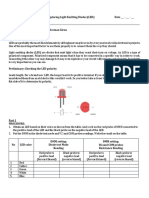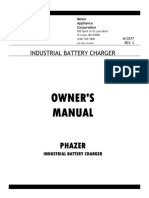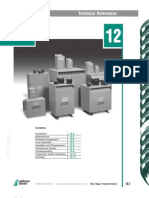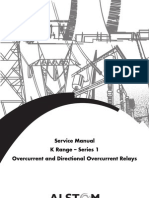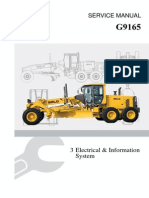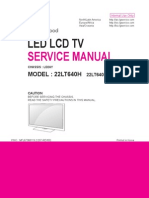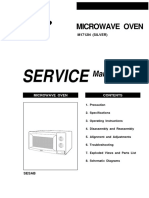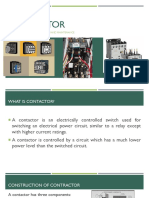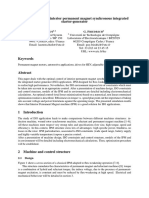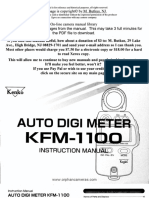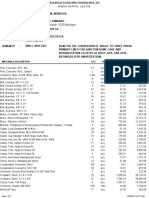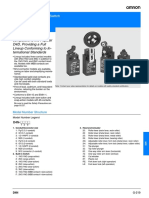Preventive Maintenance & Routine Inspection of Contactors
Preventive Maintenance & Routine Inspection of Contactors
Uploaded by
Nor Hassan AmbaCopyright:
Available Formats
Preventive Maintenance & Routine Inspection of Contactors
Preventive Maintenance & Routine Inspection of Contactors
Uploaded by
Nor Hassan AmbaOriginal Description:
Original Title
Copyright
Available Formats
Share this document
Did you find this document useful?
Is this content inappropriate?
Copyright:
Available Formats
Preventive Maintenance & Routine Inspection of Contactors
Preventive Maintenance & Routine Inspection of Contactors
Uploaded by
Nor Hassan AmbaCopyright:
Available Formats
PREVENTIVE MAINTENANCE & ROUTINE INSPECTION OF CONTACTORS:
Preventive attention is better than cure.
Page # 1/5
PREVENTIVE MAINTENANCE & ROUTINE INSPECTION OF CONTACTORS
A. B. GENERAL INSPECTION:
A.1. Check for loose, missing, broken or corroded hardware, pivot pins, cotter pins, springs and other mechanical parts.
ARC BOXES:
B.1. B.2. B.3. Check arc boxes for broken or eroded parts and Grid plates and also for excessive collection of contact material or other foreign conducting material on the surface of insulating parts. Replace broken or badly eroded parts. Clean or replace parts having excessive build of conducting material.
C.
CONTACTS:
C.1. C.2. C.3. C.4. C.5. Remove oxide or large beads of contact materials from the faces of contacts, using a fine file or sandpaper.(Emery cloth should not be used for cleaning contacts.) Do not file or sand silver or alloy contact faces unless considerable foreign matter has collected on the surface of the contacts. When replacing contacts or other current-carrying parts, clean surfaces, which are to be bolted together. Realign contacts and set over travel if necessary. Do not substitute contact material without factory approval.
D.
SHUNTS:
D.1. D.2. Replace shunts having broken of frayed strands. Clean connection points if current-carrying parts are discolored.
E. F.
BLOWOUT COILS:
E.1. Inspect blowout coils for discolored connections, shorted turns, and loose hardware.
TERMINALS, CNTACT SUPPORTS, BUS BARS, AND CONNECTORS.
F.1. F.2. Discolored connections usually indicate that overheating has occurred, probably because of loose connections. Clean connection points which are discolored and tighten all hardware.
PERFECT ELEKTRO MEK PAKISTAN Perfection with convenience
Suit # 5, 2nd floor Business Arcade, Defense More Walton Road, Lahore-Cantt. Ph. 042-668-0902/03. Fax: 042-668-6685. E mail: pempak@hotmaul.com
PREVENTIVE MAINTENANCE & ROUTINE INSPECTION OF CONTACTORS:
Preventive attention is better than cure.
Page # 2/5
G.
INSULATORS.
G.1. G.2. G.3. G.4. Remove dust and dirt from insulating parts. If carbonized tracks or cracked or broken insulators are found, replace the defective parts. As a last resort, carbonized tracks may be scraped clean and painted with insulating varnish. Before a repaired part is put into service give it an over voltage test.
H.
MAGNET ASSEMBLY.
H.1. H.2. H.3. H.4 Check magnet for dirty or corroded pole faces, pivot points, and other moving parts. Check for loose, broken, or missing shading coils, residual shims, and hardware. Inspect operating coil for evidence of electrical or mechanical damage. Operate armature by hand and check for mechanical interference and friction.
I.
ELECTRICAL OPERATION.
I.1. I.2. I.3. I.4. Operate the contactor electrically without load and observe magnet operation to be sure it opens and closes cleanly and that armature is fully sealed in the closed position. If an a-c magnet is used, check for abnormal Magnet noise. Test a sample of oil used with oil-immersed contactors and fill oil tank to the proper level with good oil. Megger insulation between phases, to ground, and to the control circuit. Operate the contactor under load and check for abnormal report and arcing both on opening and closing. A Loud report and arcing on closing is usually due to contact bounce. The magnitude of the report and arcing found on opening and closing will depend upon the type of contactor, operating load, and phase angle at which the contacts separate or touch. Since no absolute standard can be set for covering this detail, it will be necessary to judge performance on the basis of past experience with equipment when it was new or with other applications having similar equipment and operating conditions.
J.
Sl A.
01
ELECTRICAL OPERATION.
The following table will be of great help in trouble shooting of contactors: Trouble/Defect Cause MAGNET.
Coil Burned out. Mechanical damage. Protective resistance or high resistance winding is not Inserted in series with d-c coil when armature seals in. Coil voltage is too high.
What to do/Remedy
Replace. Adjust, repair, or replace interlock and series resistance so that continuous rating of coil is not exceeded when armature is sealed. Correct coil voltage. Use higher-voltage coil.
PERFECT ELEKTRO MEK PAKISTAN Perfection with convenience
Suit # 5, 2nd floor Business Arcade, Defense More Walton Road, Lahore-Cantt. Ph. 042-668-0902/03. Fax: 042-668-6685. E mail: pempak@hotmaul.com
PREVENTIVE MAINTENANCE & ROUTINE INSPECTION OF CONTACTORS:
Preventive attention is better than cure. Ambient temperature is too high. Intermittent coil is energized too long. Jogging duty is too severe. Abnormal atmosphere. Defective coil. Low voltage. Mechanical interference or friction Magnetic lockout. Provide better ventilation. Relocate starter. Re-adjust operating cycle. Check factory for special coil. Readjust operating cycle. Check factory for special coil. Relocate starter. Check factory for special coil. Replace. Correct coil voltage or system Voltage. Check mechanical operation by hand and make necessary Adjustments and/or repairs. Use nonmagnetic-armature-stop details. Add nonmagnetic Shim between armature and armature stop. Check mechanical operation by hand and make necessary adjustments and/or repairs. Replace springs. Remove friction from moving contact assembly. Adjust spring length if adjustment is provided. Correct coil Voltage or System Voltage. Use lower-voltage coil. Adjust, repair, or replace interlock and/or series resistance.
02
Does not pick up.
03.
Does not seal; hesitates at Contact touch; drops open to contact touch. (This condition may exist only when operating coil is hot or line voltage is low.)
Mechanical interference or friction. Contact force too high. Coil voltage too low. Series protective resistance or high-resistance coil winding is inserted too early, or series resistance is too high (For DC Magnets). Coils of two-coil d-c magnet have bucking polarity.
04.
Does not dropout, dropout is sluggish.
or
Dirt or grease on pole faces. Mechanical interference or friction. Residual shim is pounded down or is missing. Residual air gap is pounded down. Kick out spring is defective or missing. Control relay does not open d-c side of rectifier. Control relay has long arcing time.
Reverse polarity of one coil and check operation with load disconnected. Clean. Check mechanical operation by hand and make necessary adjustments and/or repairs. Replace residual shim or magnet assembly. Replace (Kick out spring is not used on all contractors). Add contact in control circuit. Repair or replace relay. Repair or replace relay. Replace coil. Adjust or Replace.
05.
Magnet chatter or
Shorted coil turns. (DC Magnet) Shading coil broken or out of place.
PERFECT ELEKTRO MEK PAKISTAN Perfection with convenience
Suit # 5, 2nd floor Business Arcade, Defense More Walton Road, Lahore-Cantt. Ph. 042-668-0902/03. Fax: 042-668-6685. E mail: pempak@hotmaul.com
PREVENTIVE MAINTENANCE & ROUTINE INSPECTION OF CONTACTORS:
Preventive attention is better than cure. pumping. Series protective resistance or high-resistance coil Winding is inserted too early, or series resistance is too high or is open. (Applies to DC magnets having over voltage during Pickup.) Chattering contacts on control relay, control switch, Pressure switch, temperature switch, etc. Adjust, Repair or replace interlock and/or series resistance.
06.
Noisy a-c magnet.
Loose connections. Armature does not seal in tight. Pole faces rough. Magnet misaligned. Shading coil broken or out of place. Coil voltage is low.
Check over travel and contact force on control device. Replace control device. Move control device to a location having less vibration, or insulate control device from shock And vibration. Tighten connections. Clean pole faces. Remove mechanical interference and/or friction. Replace magnet assembly. File pole faces as a last resort If new parts are not available. Realign. Replace. Correct coil voltage or system voltage. Reduce load. Use larger contactor. Clean discolored or dirty Connections and retighten. Adjust over travel, replace contacts, and replace contact Springs as required to correct defect. Clean with fine file or sandpaper. Use dust -tight enclosure for dusty atmosphere. Change operating procedure. Check factory for more Suitable contacts Reduce load. Provide better ventilation. Relocate starter. Use larger contactor. Apply cable in line with existing load. Adjust over travel, replace contacts, and replace contact spring See Magnet, this table. See Magnet, this table. See Magnet this table. Correct coil over voltage condition. Correct mechanical defects.
B. 01.
Overheating.
Contacts. Load current too high. Loose connections. Over travel and/or contact force too low. Collection of copper oxide or foreign matter on contact Faces. Load is on in excess 8hr. Ambient temperature is too high. Line and/or load cables are too small. Over travel and/or contact force is too low. Magnet stalls or hesitates at contact touch point. Magnet drops open at contact touch due to voltage dip. Magnet chatter. Contact bounce on closing.
02.
Welding of contacts.
PERFECT ELEKTRO MEK PAKISTAN Perfection with convenience
Suit # 5, 2nd floor Business Arcade, Defense More Walton Road, Lahore-Cantt. Ph. 042-668-0902/03. Fax: 042-668-6685. E mail: pempak@hotmaul.com
PREVENTIVE MAINTENANCE & ROUTINE INSPECTION OF CONTACTORS:
Preventive attention is better than cure. Contacts rebound to contact touch when opening. Poor contact alignment. Jogging duty is too severe. Excessive inrush current. Correct mechanical defects in stop assembly. Correct Mechanical defects in latch if one is used. Adjust contacts to touch simultaneously within 1/32 in. Reduce jogging cycle. Check factory for more weld-resistant contact material. Use larger contactor. Readjust accelerating time or operating sequence. Use larger contactor. Check factory for more weld-resistant contact material. Move starter to location having less shock and vibration. Insulate starter from shock and vibration. Provide more rigid Support for starter. Reduce jogging cycle. Check factory for more durable contact material. Use larger contactor. Air break contactors may have 10 to 20 times longer contact life than oil-immersed contactors of equal ratings
Vibration in starter mounting.
Jogging cycle is too severe.
C. Poor arc interruption.
Oil-immersed contactor is used where an air break Contactor could be used. ARC INTERRUPTION Arc box not in place. Install arc box in line with instruction-leaflet data. Arc box damaged. Replace broken or eroded insulating parts, arc horns, and grid plates. Clean or replace insulating parts having a heavy Coating of foreign conducting material. Dirt or paint on arc horns or steel grid plates. Remove insulating materials, which may have accumulated on arc horns and steel grid plates. Magnetic hardware substituted for nonmagnetic Replace with correct hardware. hardware in arc box and blowout assemblies. Blowout coil reversed or short-circuited. Replace coil. Correct defect. Magnet opening is sluggish. See Magnet, this Table.
PERFECT ELEKTRO MEK PAKISTAN Perfection with convenience
Suit # 5, 2nd floor Business Arcade, Defense More Walton Road, Lahore-Cantt. Ph. 042-668-0902/03. Fax: 042-668-6685. E mail: pempak@hotmaul.com
You might also like
- MulMob2.5 TroubleshootingDocument39 pagesMulMob2.5 Troubleshootinghageji163.comNo ratings yet
- Led Monitor: Service ManualDocument16 pagesLed Monitor: Service ManualabdelkaderNo ratings yet
- Laboratory Experiment 2 Colored LEDs PDFDocument3 pagesLaboratory Experiment 2 Colored LEDs PDFMary Joyce Roxas100% (1)
- Electrical Wiring Diagram - Caterpillar Model 3054 S/No. Prefix 330 & 334Document2 pagesElectrical Wiring Diagram - Caterpillar Model 3054 S/No. Prefix 330 & 334Lis100% (1)
- Summary Ac Contactor Failure Cause and EffectDocument9 pagesSummary Ac Contactor Failure Cause and EffectVinci Valcu ParneNo ratings yet
- HT and LT VCB MaintenaceDocument30 pagesHT and LT VCB Maintenacekartik bhagatNo ratings yet
- Ijert Ijert: Dynamic Contact Resistance Measurements On HV Circuit BreakerDocument5 pagesIjert Ijert: Dynamic Contact Resistance Measurements On HV Circuit Breakerkokonut1128No ratings yet
- Cranes and Derricks in Construction Shift and Monthly Inspection ChecklistDocument3 pagesCranes and Derricks in Construction Shift and Monthly Inspection ChecklistRabar TahaNo ratings yet
- Ac Contactor Common Faults and Maintenance Case AnalysisDocument3 pagesAc Contactor Common Faults and Maintenance Case AnalysisZelalem LeyikunNo ratings yet
- R8035 FDocument16 pagesR8035 FVishwanath TodurkarNo ratings yet
- S-T MaintenanceManualDocument34 pagesS-T MaintenanceManualgeraleao208No ratings yet
- Procedure of Maintenance For Electrical EquipmentDocument16 pagesProcedure of Maintenance For Electrical EquipmentThức Võ100% (2)
- Modern Trends and Accident Prevention On Distribution and Power TransformersDocument10 pagesModern Trends and Accident Prevention On Distribution and Power Transformersashutosh2009No ratings yet
- RelaysReliability PDFDocument8 pagesRelaysReliability PDFcazzocazzocazzoNo ratings yet
- Trouble Shooting Capacitor Regulated Pancake Light Tower GeneratorsDocument7 pagesTrouble Shooting Capacitor Regulated Pancake Light Tower GeneratorsBilly MecanizadoNo ratings yet
- Damage Due To Esd Allpl Note Avago TechDocument4 pagesDamage Due To Esd Allpl Note Avago TechhimsnileshNo ratings yet
- Del Core My ElectricalDocument56 pagesDel Core My Electricaljohanbl88No ratings yet
- Practical Work No 6Document5 pagesPractical Work No 6Potter A. VijayNo ratings yet
- M13577 Phazer Owners ManualDocument10 pagesM13577 Phazer Owners ManualIntercambio de ManualesNo ratings yet
- Body Electrical SystemDocument59 pagesBody Electrical SystemLeonardo Gómez Berniga100% (1)
- USCO CatalogDocument56 pagesUSCO CatalogDavid LeviNo ratings yet
- ElectricalDocument7 pagesElectricalUFC Fight ClubNo ratings yet
- Tech Welded ContactsDocument2 pagesTech Welded ContactsHamza HammadiNo ratings yet
- SUBSTATIONDocument22 pagesSUBSTATIONAmrit Aggarwal100% (1)
- Control of Electrical MachinesDocument14 pagesControl of Electrical MachinesabdulrahmanalnjNo ratings yet
- Areva MVTT Relay ManualDocument42 pagesAreva MVTT Relay ManualjbatoyNo ratings yet
- DET-456 PowerVac Metal-Clad Switchgear and Vacuum Circuit Breakers Maintenance and Troubleshooting SuggestionsDocument26 pagesDET-456 PowerVac Metal-Clad Switchgear and Vacuum Circuit Breakers Maintenance and Troubleshooting SuggestionsricardodtramosNo ratings yet
- Large HV Machine Repair: Repair Options & Rewind Good Practice With Examples of More Unusual RepairsDocument9 pagesLarge HV Machine Repair: Repair Options & Rewind Good Practice With Examples of More Unusual RepairsmersiumNo ratings yet
- IEE LAB MANUAL-CombinationDocument34 pagesIEE LAB MANUAL-Combinationaaravind0598No ratings yet
- Circuit BreakersDocument3 pagesCircuit BreakersJitendra KumarNo ratings yet
- Instruction Manual of EDM MachineDocument18 pagesInstruction Manual of EDM MachineJanak ValakiNo ratings yet
- Technical ReferencesDocument16 pagesTechnical Referencessudhi_786No ratings yet
- Tm170tig PVCDocument9 pagesTm170tig PVCAndrea MorsianiNo ratings yet
- Abb ContactorabbDocument16 pagesAbb ContactorabbRoga29No ratings yet
- Unit-Iii Risks During Installation of Electric Plant and EquipmentDocument9 pagesUnit-Iii Risks During Installation of Electric Plant and EquipmentsaraswatthiNo ratings yet
- If Trouble Occurs. (2) To Repair Trouble Cause TroubleshootingDocument1 pageIf Trouble Occurs. (2) To Repair Trouble Cause TroubleshootingbayuNo ratings yet
- CL-21Z50MQ K16CDocument73 pagesCL-21Z50MQ K16CRonald CastellarNo ratings yet
- BTC30 40insDocument4 pagesBTC30 40inspatgarettNo ratings yet
- R8501G K1RangeDocument208 pagesR8501G K1RangeRinda_RaynaNo ratings yet
- Microwave Ovens Repair - Sci - Electronics.repair FAQ Notes On The TroubleshootingDocument10 pagesMicrowave Ovens Repair - Sci - Electronics.repair FAQ Notes On The TroubleshootingDonny ChordsNo ratings yet
- Revision Harness y ConectoresDocument9 pagesRevision Harness y ConectoresVladimir Illich Pinzon BallenNo ratings yet
- Electrical Substation Switch Yard General EquipmentsDocument22 pagesElectrical Substation Switch Yard General EquipmentsAnand SwamiNo ratings yet
- Acb Fault ReasonsDocument14 pagesAcb Fault ReasonsDakshinaMoorthyNo ratings yet
- 2014 Led LG 32lb55-A-T - Chassis Lb45bDocument58 pages2014 Led LG 32lb55-A-T - Chassis Lb45bdanielradu2760% (5)
- MC-300 CD - Service ManualDocument28 pagesMC-300 CD - Service ManualMilorad Pajovic100% (1)
- 3electrical & Information System - ENGLISG-G9165Document48 pages3electrical & Information System - ENGLISG-G9165George Jhonson100% (4)
- Manual 2Document0 pagesManual 2Rafat ThongNo ratings yet
- TV Samsung CL29A551GQ9XZD Chassis KSDA-N-CB5G Manual de ServicioDocument73 pagesTV Samsung CL29A551GQ9XZD Chassis KSDA-N-CB5G Manual de ServicioGabriel Grieco100% (3)
- Led LCD TV: Service ManualDocument60 pagesLed LCD TV: Service ManualFrank VillaNo ratings yet
- Samsung m1712n Silver SMDocument23 pagesSamsung m1712n Silver SMdieselroarmt875bNo ratings yet
- Contactor: Electrical Equipment Operation and MaintenanceDocument23 pagesContactor: Electrical Equipment Operation and MaintenanceKenneth Lewis100% (1)
- Electrical Panel Inspection & MaintenanceDocument4 pagesElectrical Panel Inspection & MaintenanceFawaaz KhurwolahNo ratings yet
- 23990-01 ELECTRICAL SYSTEM REQUIREMENTSDocument8 pages23990-01 ELECTRICAL SYSTEM REQUIREMENTSEnder Quinzander Tovar HernandezNo ratings yet
- Er 105 3 1Document7 pagesEr 105 3 1edgarafonsecaNo ratings yet
- JVC mx-gt80 gt90 SM No-Sch (ET)Document48 pagesJVC mx-gt80 gt90 SM No-Sch (ET)Cliffton FilipinoPrd ShraderNo ratings yet
- Led LCD TV: Service ManualDocument42 pagesLed LCD TV: Service ManualJm QuemadoNo ratings yet
- Introduction to Power System ProtectionFrom EverandIntroduction to Power System ProtectionRating: 5 out of 5 stars5/5 (1)
- Industrial Power Transformers: Selection, Installation, Advanced Maintenance and ReliabilityFrom EverandIndustrial Power Transformers: Selection, Installation, Advanced Maintenance and ReliabilityNo ratings yet
- Industrial Electric Motors: Installation, Running, Advanced Maintenance and ReliabilityFrom EverandIndustrial Electric Motors: Installation, Running, Advanced Maintenance and ReliabilityNo ratings yet
- Boat Maintenance Companions: Electrics & Diesel Companions at SeaFrom EverandBoat Maintenance Companions: Electrics & Diesel Companions at SeaNo ratings yet
- Investment CalculationDocument1 pageInvestment CalculationNor Hassan AmbaNo ratings yet
- OrgChartAdminFinance WebDocument4 pagesOrgChartAdminFinance WebNor Hassan AmbaNo ratings yet
- South Africa Works Public Works: Because ofDocument104 pagesSouth Africa Works Public Works: Because ofNor Hassan AmbaNo ratings yet
- What Is Medical Equipment and Types of Medical EquipmentDocument5 pagesWhat Is Medical Equipment and Types of Medical EquipmentNor Hassan AmbaNo ratings yet
- XRF - ElvaXPlusDocument4 pagesXRF - ElvaXPluswulalan wulanNo ratings yet
- DVD7108 704725272Document17 pagesDVD7108 704725272Ivan MiguelNo ratings yet
- KOKS 24 (25) - 1VLC000511 Rev. 3, enDocument5 pagesKOKS 24 (25) - 1VLC000511 Rev. 3, enTetianaNo ratings yet
- 7fbe10-20 (1) 303Document8 pages7fbe10-20 (1) 303johnNo ratings yet
- REFRACTION OF LIGHT by Prakash ProtectedDocument42 pagesREFRACTION OF LIGHT by Prakash ProtectedprakashNo ratings yet
- System Wiring DiagramsssDocument175 pagesSystem Wiring DiagramsssFahru ZainiNo ratings yet
- Optimal Control of Interior Permanent Magnet Synchronous Integrated Starter-GeneratorDocument9 pagesOptimal Control of Interior Permanent Magnet Synchronous Integrated Starter-GeneratorMuhammad MudassarNo ratings yet
- 1 Reading Instructions For Drawings: Wärtsilä Finland Oy Vaasa Engineering OyDocument13 pages1 Reading Instructions For Drawings: Wärtsilä Finland Oy Vaasa Engineering Oyrakibul hasanNo ratings yet
- Kenko - Auto - Digi - kfm-1100 2040Document37 pagesKenko - Auto - Digi - kfm-1100 2040Marco PeixotoNo ratings yet
- Philips Downlight 7 WattDocument2 pagesPhilips Downlight 7 WattZefRy D'e DSNo ratings yet
- Result ConsolidatedDocument1 pageResult ConsolidatedHero KurellaNo ratings yet
- Generator Third-Harmonic Protection Explained: Schweitzer Engineering Laboratories, IncDocument10 pagesGenerator Third-Harmonic Protection Explained: Schweitzer Engineering Laboratories, IncPrateek Singh TomarNo ratings yet
- Iec 61869 1 2007 10 PDFDocument134 pagesIec 61869 1 2007 10 PDFcamiloNo ratings yet
- Antipolo Del Norte, Lipa City: SubjectDocument3 pagesAntipolo Del Norte, Lipa City: SubjectRamled RerrefNo ratings yet
- Service Manual: Color Television ReceiverDocument39 pagesService Manual: Color Television ReceiverRicardo SevillaNo ratings yet
- 4 Ece LIC EC2254 QPFirst Internal ASSDocument1 page4 Ece LIC EC2254 QPFirst Internal ASSBIBIN CHIDAMBARANATHANNo ratings yet
- Katalog ENDocument24 pagesKatalog ENtest asdNo ratings yet
- Eeen 301 Lecture IiDocument23 pagesEeen 301 Lecture IiKabiru FaisalNo ratings yet
- Phy 201 3 Sem3pdfDocument6 pagesPhy 201 3 Sem3pdfshreeramsharmaNo ratings yet
- Comparison: 5.1 Comparison With Previous ModelDocument4 pagesComparison: 5.1 Comparison With Previous ModelPrianurraufikachmadNo ratings yet
- Allanson Luminous Tube Footage ChartDocument2 pagesAllanson Luminous Tube Footage ChartpartsforsignsNo ratings yet
- Project PPT Line Follower RobotDocument24 pagesProject PPT Line Follower Robotbhuvnesh33% (3)
- Ultrafast Soft Recovery Diode: T 60ns I 150amp V 400VDocument6 pagesUltrafast Soft Recovery Diode: T 60ns I 150amp V 400VTan Hung LuuNo ratings yet
- A Single Phase Integrated Battery Charger With Active Power Decoupling For Electric VehiclesDocument6 pagesA Single Phase Integrated Battery Charger With Active Power Decoupling For Electric VehiclesDEBARATI DAMNo ratings yet
- Gujcet - D25 Apr 2024Document13 pagesGujcet - D25 Apr 2024moxits76No ratings yet
- Question Bank 2Document11 pagesQuestion Bank 2IppiNo ratings yet
- Barbosa and Leal Devices - Info and Replication Details - Page 36 - Energetic Forum PDFDocument27 pagesBarbosa and Leal Devices - Info and Replication Details - Page 36 - Energetic Forum PDFSuriadi Ishak0% (1)


